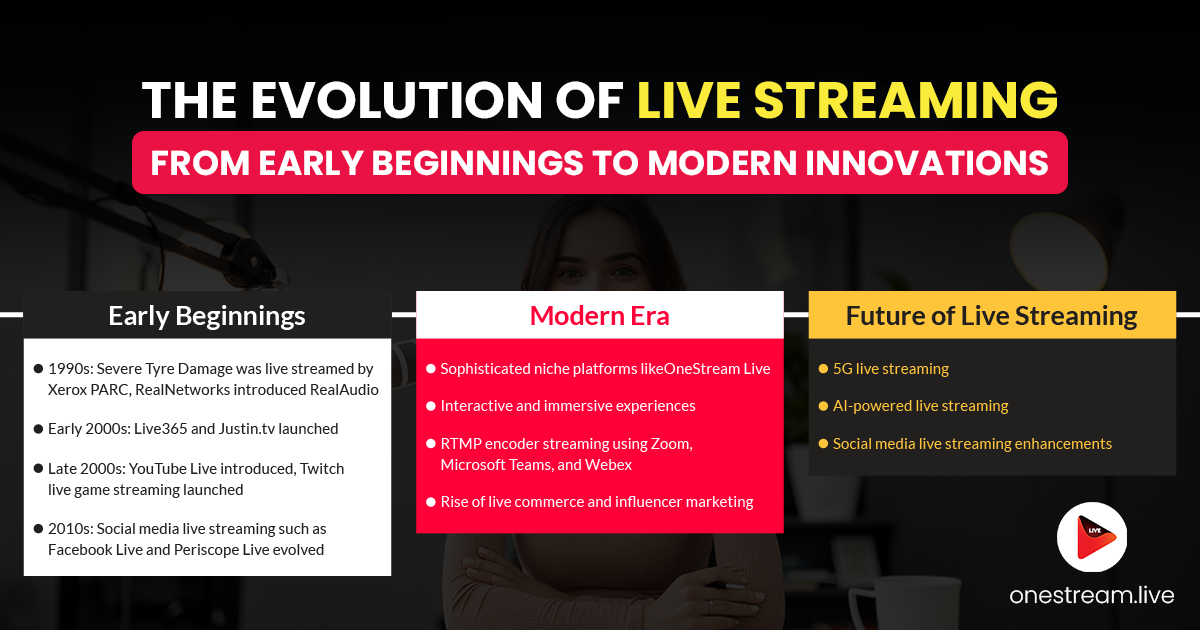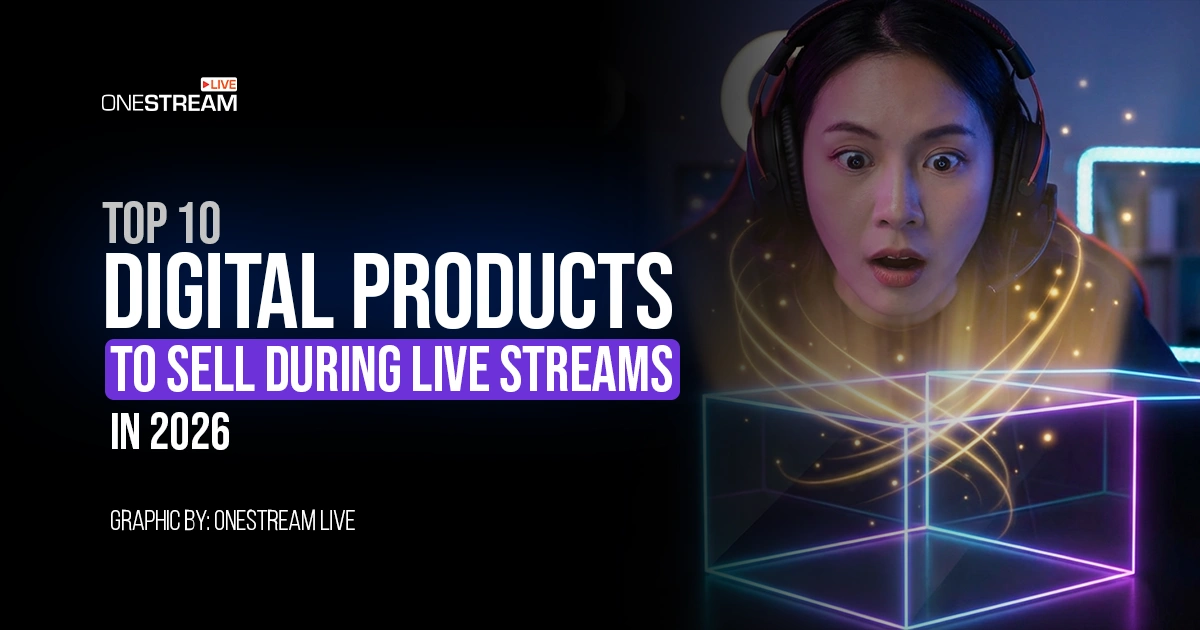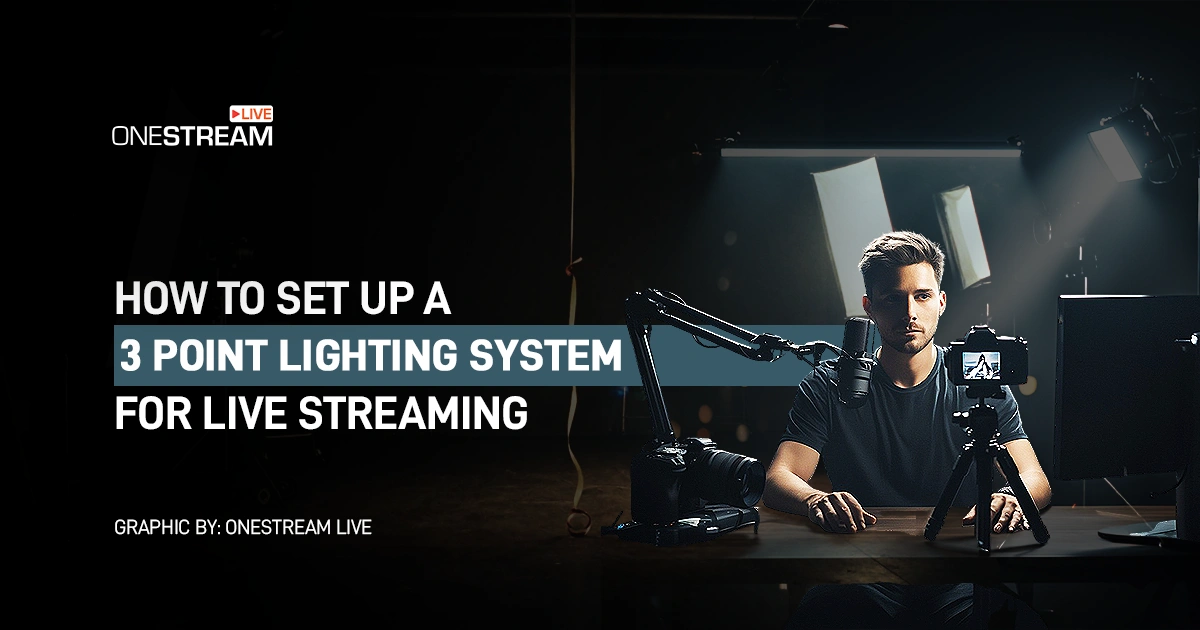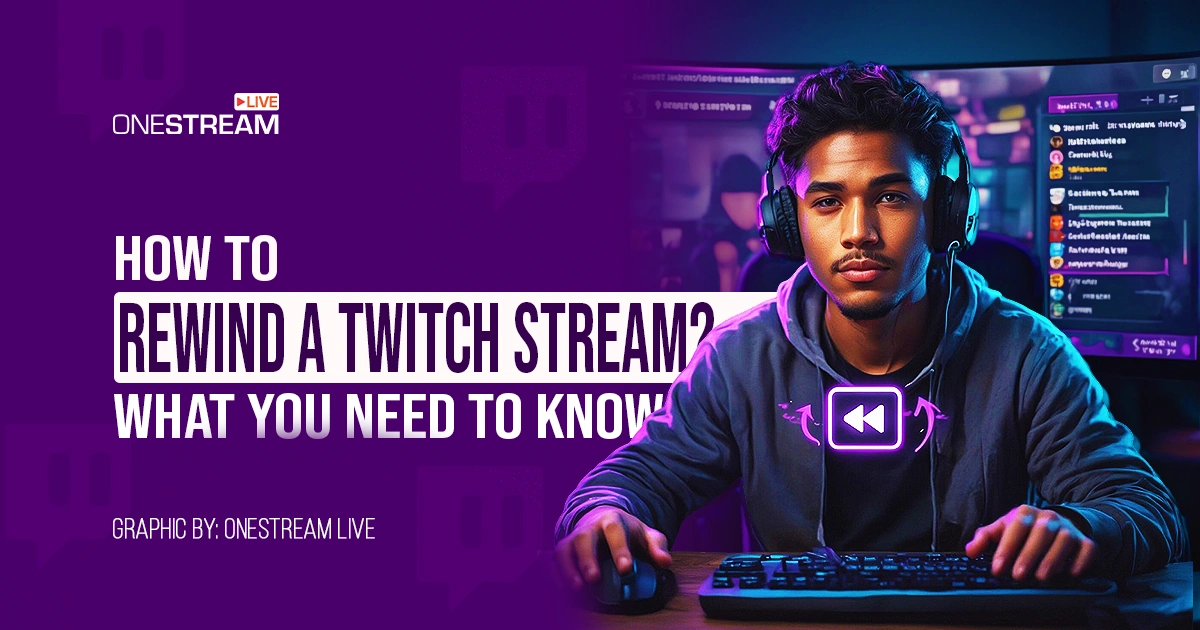Our digital lives now revolve around live streaming, which shapes our real-time communication, content consumption, and interaction. The evolution of live streaming from its lowly origins in the early days of the internet to the sophisticated, high-quality broadcasts we enjoy today reflects wider technical developments and shifts in consumer behavior. This thorough blog will cover the background, significant advancements, and prospects for live streaming going forward. It will also emphasize its effects on many industries and its place in our globally linked society.
Introduction to the Evolution of Live Streaming
The 1990s: The Pioneering Days
When did live streaming start? Live streaming originated in the mid-1990s when personal computer ownership was rising, and internet technology was advancing quickly. One of the first prominent incidents occurred in 1993 when Xerox PARC (Palo Alto Research Centre) live streamed ‘Severe Tyre Damage.’ Even though it was simple by today’s standards, this event was important since it proved that live video transmission via the Internet was possible.
RealNetworks (formerly Progressive Networks) debuted RealAudio, an internet audio streaming program, in 1995. This breakthrough prepared the way for the next advances in live video broadcasting. By the late 1990s, technology expansion by companies like RealNetworks enabled the first live streams of concerts, sporting events, and political happenings.
The Early 2000s: The Rise of Broadband
Early in the new millennium, the switch from dial-up to broadband internet greatly improved live streaming. Higher quality audio and video feeds made possible by quicker internet speeds made live streaming more approachable and pleasurable for the typical user. Live365 and Justin.tv were two live streaming-focused websites that debuted around this time.
Launched in 2007, Justin.tv was very well-known. One of the creators, Justin Kan, had a single channel that streamed his life around the clock. The technology swiftly developed to let everyone make their own live streams, which set the stage for the variety and user-generated material that define contemporary live streaming services.
Technological Advancements and the Evolution of Live Streaming
The Late 2000s: Emergence of Major Platforms
Major live streaming services that would rule the market first appeared in the late 2000s. YouTube, already a video content behemoth, debuted live streaming in 2008. This critical step integrated live streaming with YouTube’s vast audience and advanced infrastructure, marking it as one of the first platforms where live streaming truly took off.
Launched in 2011, Twitch was first a video game broadcasting spin-off from Justin.tv. It quickly became a byword for live game streaming among gamers and esports fans. The interactive elements on Twitch, such as live chat and viewer subscriptions, created a community and level of interaction that raised the bar for live streaming services.
The 2010s: Mobile and Social Media Integration
When did live streaming start? As the timeline of streaming services continued into the 2010s, the convergence of social media, mobile devices, and live streaming created a new dynamic in content delivery. The proliferation of smartphones equipped with excellent cameras and robust internet capabilities meant anyone could live stream virtually anywhere. Platforms like Facebook Live, which debuted in 2016, and Periscope, introduced in 2015, exploited this trend by providing smooth live broadcasting capabilities within their social networks.
Because Facebook Live was integrated into the world’s largest social media network, it particularly reached a vast audience. Celebrities, news organizations, and brands quickly embraced Facebook Live to interact with their viewers in real time, making live streaming commonplace.
Advances in Streaming Technology
So, who invented streaming? While the concept of live streaming evolved over the years, technological advancements during this period played a crucial role in enhancing the experience. Adaptive bitrate streaming, which adjusts the quality of a video stream in real-time based on the viewer’s internet connection, became a standard feature, ensuring smoother and more reliable broadcasts.
Moreover, the development of Content Delivery Networks (CDNs) improved the distribution of live streams by caching content closer to viewers, reducing latency and buffering issues and shaping the history of live streaming into what it is today.
The Modern Era: Diversification in the Evolution of Live Streaming
The Rise of Niche Platforms
As the evolution of live streaming continued to advance, specialized platforms catering to niche interests began to emerge. Platforms like Mixer (formerly Beam), which focused on ultra-low latency streaming for gamers, and DLive, a blockchain-based streaming platform, offered unique features tailored to specific communities.
OneStream Live allows for multi-streaming on 45+ social media platforms and any custom RTMP destination simultaneously, marking a significant point in the timeline of streaming services. These niche platforms provided alternatives to mainstream services, fostering diversity in the evolution of live streaming ecosystem.
Live Streaming in Professional Contexts
The evolution of live streaming also found significant applications in professional and business contexts, becoming integral during the COVID-19 pandemic. Platforms like Zoom, Microsoft Teams, and Webex became essential for remote work and virtual events, showcasing the versatility and importance of live streaming technology beyond entertainment.
This era highlighted how when live streaming started, it was primarily for entertainment but has since evolved to become a critical business tool.
Interactive and Immersive Experiences
Modern live streaming has increasingly incorporated interactive and immersive elements to enhance viewer engagement. Features like live polls, Q&A sessions, and interactive overlays facilitate real-time interaction, significantly enriching the viewer experience.
Moreover, the integration of augmented reality (AR) and virtual reality (VR) into live streaming offers immersive experiences that blend virtual and physical realities, redefining what was the first platform to utilize these technologies fully. This also represents a cutting-edge phase in the evolution of live streaming
Monetization and Content Creation
Monetization strategies have evolved significantly during the evolution of live streaming. Beyond traditional advertising, platforms now offer various revenue streams for content creators, including subscriptions, donations, and virtual gifts. For instance, Twitch’s affiliate and partner programs enable streamers to generate income through subscriptions, Bits (a virtual currency), and ad revenue, marking a new chapter in the history of live streaming.
The rise of live commerce, where influencers and brands sell products during live streams, has become a major trend, particularly in regions like Asia. Platforms like Taobao Live in China have demonstrated the potential of live streaming as a powerful e-commerce tool, combining entertainment with real-time shopping experiences and marking a significant milestone in the evolution of live streaming.
The Future of Live Streaming: Trends and Innovations
5G and Beyond
As part of the continuing evolution of live streaming, 5G technology is set to revolutionize the industry with much faster internet speeds and significantly reduced latency. This advancement is expected to provide more immersive and interactive experiences and higher-quality streaming, including 4K and 8K resolutions.
Moreover, the increased bandwidth and reliability of 5G networks will promote the expansion of mobile live streaming and the proliferation of Internet of Things (IoT) devices with live broadcasting capabilities.
Artificial Intelligence and Machine Learning
The future of live streaming will increasingly rely on machine learning (ML) and artificial intelligence (AI). AI-driven algorithms can enhance content moderation, suggest streams according to viewer preferences, and instantly improve video quality, shaping the timeline of streaming services.
Additionally, machine learning will also create more personalized and engaging experiences, such as automatic highlights of significant events in live broadcasts and real-time language translation, marking important milestones in the history of live streaming.
Integration with Social Media and Emerging Platforms
Live streaming will continue to integrate with social media and emerging digital platforms. As social media networks evolve, they will likely incorporate more sophisticated live streaming features, enabling deeper interaction and engagement.
Moving on, emerging platforms like the metaverse will also provide new avenues for live streaming, offering virtual spaces where users can interact and participate in live events in entirely new ways, contributing to the evolution of live streaming.
Conclusion: Reflecting on the Evolution of Live Streaming
The evolution of live streaming from its early beginnings to modern innovations is a testament to the transformative power of technology. What started as a novel experiment in the early days, marked by the first livestream in the 1990s, has grown into a global phenomenon, profoundly shaping how we consume content, interact, and engage with the world around us. As the evolution of live streaming continues, driven by advancements like when live streaming started and the timeline of streaming services, it will undoubtedly play an even more significant role in our digital future.
From entertainment and education to business and beyond, the possibilities for live streaming are vast and exciting, promising a future where when was live streaming invented will be seen as a pivotal moment in creating real-time, interactive, and immersive experiences that are integral parts of our everyday lives.
OneStream Live is a cloud-based live streaming solution to create, schedule, and multistream professional-looking live streams across 45+ social media platforms and the web simultaneously. For content-related queries and feedback, write to us at [email protected]. You’re also welcome to Write for Us!










